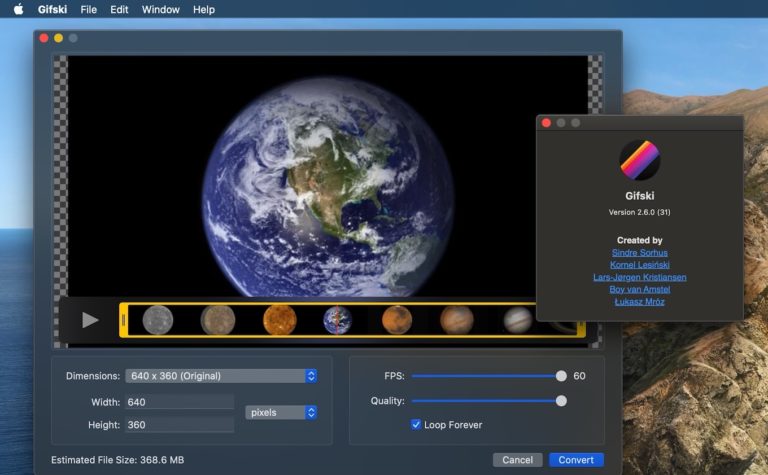


Click the link for more info.ĬURRENT VERSION: 1.1 (Monday, January 24, 2022) At the moment it isn't that different from the latest git revision anyway.
#FFMPEG VS GIFSKI INSTALL#
Or install the 'gifski' package from AUR, that has video disabled. This macro requires the end-user to set a ENV_PATH variable (or specify the path in the shell script). I would recommend building it without video if it doesn't compile for you, just edit the PKGBUILD and remove 'video' from '-features' in the build command. This macro requires Gifski (a Homebrew package) to be installed. This macro requires Homebrew to be installed. If you are running a previous version of KM, simply disable or remove said action(s).
#FFMPEG VS GIFSKI TV#
For reality TV type shows (Big Brother, The Challenge), the resulting video ends up with a lot of stuttering, artifacts in scenes with fast movement, and screen tearing when panning. This macro makes use of the following KM version 10 action(s): I use Plex to record OTA shows (from a HDHomeRun Extend with the source set to 'Highest Quality') and then use ffmpeg to hardware transcode them to save disk space. hookffmpeghtml () uses FFmpeg to convert images to a video hookgifski () uses the gifski to convert images to a GIF animation hookscianimator () uses the JavaScript library SciAnimator to create animations hookr2swf () uses the R2SWF package. NOTE: This macro has special requirements to run Thanks in advance, and if this macro proves useful to anybody else then enjoy! While the macro works quite well for me (and why I posted it here, and not in the Questions and Suggestions category), I'm still interested in everybody's thoughts and ideas if this macro can be improved. If gifski is not installed, the rendering will be much slower than using the gifskirenderer() and can potentially result in system problems when many frames need to be rendered (if gifski is installed magick will use it under the hood) avrenderer() which requies the av package and uses ffmpeg to encode the animation into a video file. No screen recording of this one as it's all done in the background. Other possible renderers are: magickrenderer () which requires the magick package and produce a gif. This renderer requires both the gifski and png packages to be installed. There is also a GUI application that I used before, and while it has certain advantages (like estimating the file size), I prefer this to be as automated as possible. The gifskirenderer () is used unless otherwise specified in animate () or in options ('gganimate.renderer'). I have been using it for a few days now to convert screen recordings of my other macros to the gif format so I can upload them to the forum here. hookffmpeghtml() uses FFmpeg to convert images to a video hookgifski() uses the gifski to convert images to a GIF animation hookscianimator() uses the JavaScript library SciAnimator to create animations hookr2swf() uses the R2SWF package. My latest one is designed to use Gifski (a Homebrew package) to convert video files to gif images.
#FFMPEG VS GIFSKI HOW TO#
Howdy folks, I've been trying to learn some how to work with shell scripts lately, so I've been making great use of Homebrew packages to make some basic macros.


 0 kommentar(er)
0 kommentar(er)
